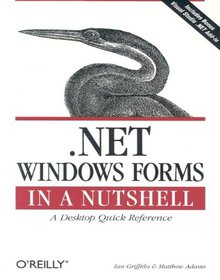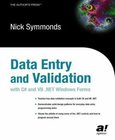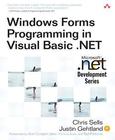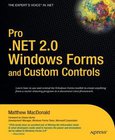.NET Windows Forms
In a Nutshell

Book Details:
| Publisher: | O'Reilly Media |
| Series: | OReilly , In A Nutshell |
| Author: | Ian Griffiths |
| Edition: | 1 |
| ISBN-10: | 0596003382 |
| ISBN-13: | 9780596003388 |
| Pages: | 936 |
| Published: | Mar 01 2003 |
| Posted: | Nov 19 2014 |
| Language: | English |
| Book format: | |
| Book size: | 0.97 MB |
Book Description:
.NET Windows Forms are a powerful technology for building a large class of applications for the Windows .NET platform. They offer nearly the same power and flexibility of classic Win32 development, but for a fraction of the effort. The programming model is lean and streamlined, and many of the tedious details that developers used to have to spend time on are now dealt with automatically by the platform..NET Windows Forms in a Nutshell offers an accelerated introduction to this next-generation of rich user interface development. The book provides an all-inclusive guide for experienced programmers using the .NET Windows Forms platform to develop Windows applications, along with a compact but remarkably complete reference to the .NET Framework Class Library (FCL) Windows Forms namespaces and types. The authors present solid coverage of the fundamental building blocks, such as Controls, Forms, Menus, and GDI+, and enough detail to help you build your own fully featured reusable visual components so you can write visual component libraries as well as standalone applications..NET Windows Forms in a Nutshell aims to provide not just the practical information and advice required to get programs working, but also to communicate the rationale behind the various parts of Windows Forms' design. The authors show how the thinking behind the framework enhances your productivity substantially. The new framework allows you to guess correctly what "the Right Way" to do things is a majority of the time, even if you've never tried what you're doing before. No more digging around in documentation for days to try to find the bit of information you need to use one particular feature.Anyone who is involved in user interface development will appreciate the ease of creation and expanded capabilities provided by .NET Windows Forms, as well as the in-depth focus and straight-forward approach this book brings. Included on CD is an add-in that will integrate the book's reference directly into the help files of Visual Studio .NET.
Download Link:
Related Books:
Data Entry and Validation
With C# and VB. NET Windows Forms
The old hacker adage Garbage in, garbage out has never been so important as it is today. With ever-increasing amounts of information flowing into and out of modern applications, the task of an application developer to control and verify information is critically important to any software project. For the first time, Data Entry and Validation with C# and VB .NET Windows Forms brings together current knowledge on this subject in an understandable, easy-to-read form. Covering development and best practices for data entry and validation, including GDI+, custom controls, localization, accessibility, proper data validation techniques, and best practices with Visual Basic and C#, Data Entry and Validation with C# and VB .NET Windows Forms is a book no moder...
Windows Forms Programming in Visual Basic .NET
Much of the publicity around .NET has focused on using .NET to build Web-based applications and Web services. Many developers, however, are using .NET to build traditional Windows-based applications. Microsoft has provided a package called Windows Forms, or WinForms, which makes the development of these apps easier and faster than ever. Chris Sells has written the definitive book to help experienced Microsoft developers master the use of this powerful toolkit. Based on the experience he has gained developing with and teaching WinForms for the last two year, he goes beyond other books currently on the market. Chris has a critically acclaimed writing style that allows him to keep the material concise and easy to follow. He concentrates on what you won'...
Pro .NET 2.0 Windows Forms and Custom Controls
Renowned author Matthew MacDonald combines careful treatment of the API with detailed user-interface design principles. Further, this book incorporates C# and the final beta of .NET 2.0. The result: thorough coverage of Windows Forms and GDI+ namespaces for .NET programmers! You will become equipped to design state-of-the-art Windows interfaces and program graphics, and learn how to create your own controls. As a developer, you must know more than just how to add a control to a window. You must be able to create an entire user interface framework that's scalable, flexible, and reusable. This book is not a reference manual. Instead, it contains detailed discussions about user interface elements that youll use on a regular basis....
2007 - 2021 © eBooks-IT.org



